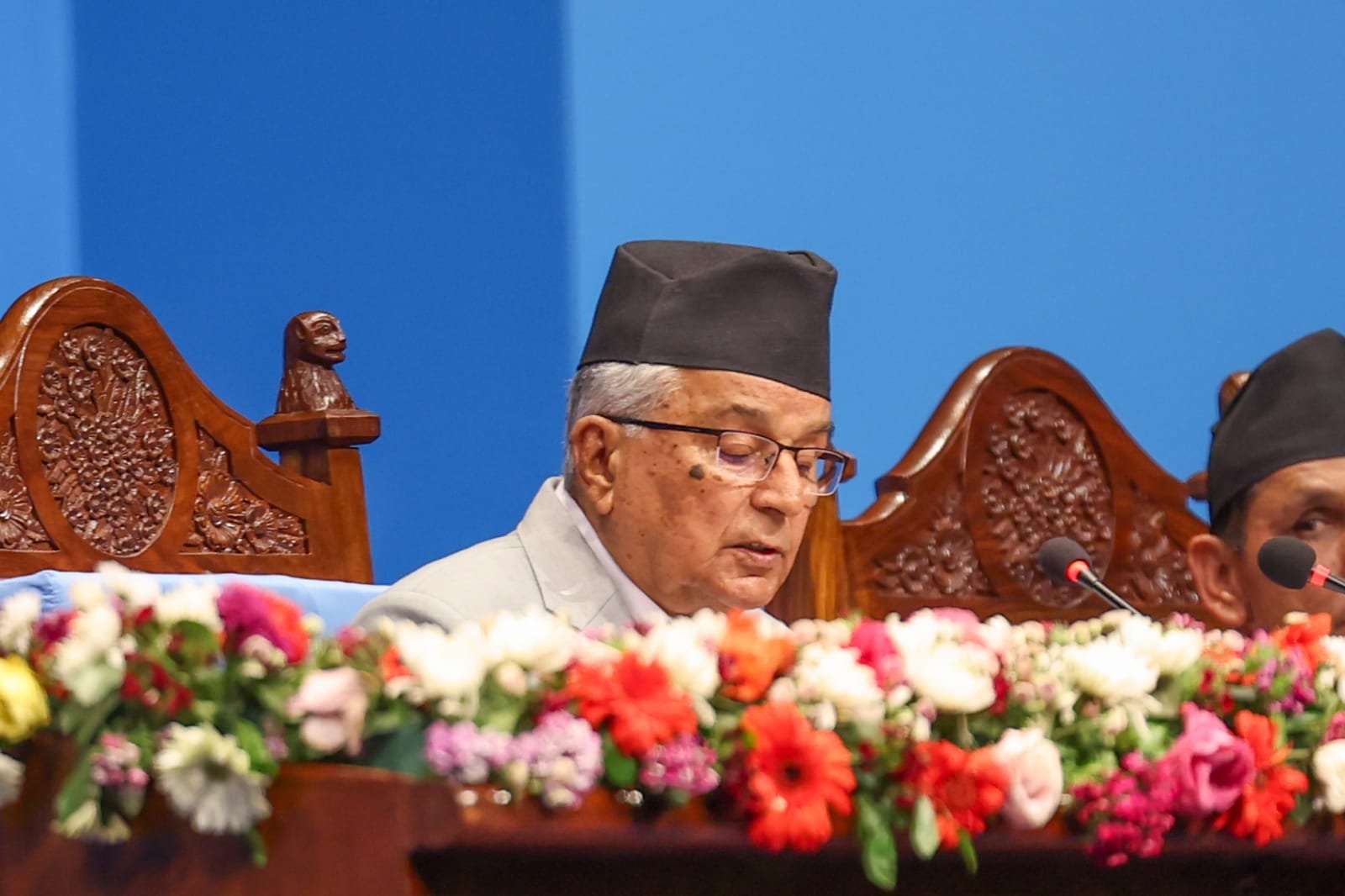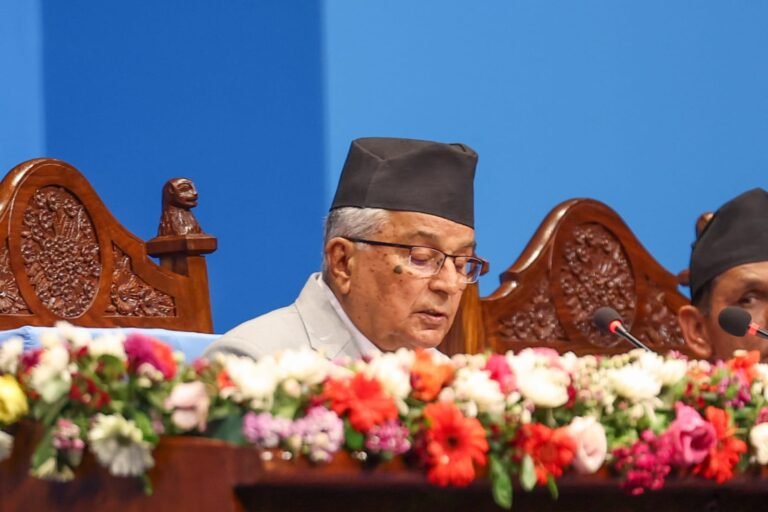Nepal’s FY 2082/83 Policy: New Fiscal Blueprint Aims to Fix the Past, Not Add to It
President Paudel pledges to reprioritise legacy infrastructure schemes while driving governance, social justice, and growth reforms.

President Paudel presents Nepal’s FY 2082/83 policy agenda during joint session of Federal Parliament in Kathmandu.
Kathmandu: In a charged political and economic atmosphere, Nepal’s federal government has tabled its Policy and Programme for Fiscal Year 2082/83 (2025/26) with a clear message: the country is in need of restructuring, not just recovery. Read by President Ram Chandra Paudel in a joint session of Parliament, the annual roadmap seeks to balance economic realism with long-term transformation, while also revisiting priorities set by past administrations.
“Infrastructure schemes from previous governments will be reprioritised,” said President Paudel, indicating a shift in focus away from symbolic or politically-driven projects toward those with feasible economic and social returns.
This marks a turning point: while continuity has often been touted, the current programme emphasizes course correction, consolidation, and correction of inefficiencies—especially in areas like infrastructure, governance, and economic planning.
ANALYSIS: Between Ambition and Reality
Despite being dressed in developmental rhetoric, the FY 2082/83 document reflects a more grounded tone than in past years. Three broad trends emerge:
-
Austerity + Rationalization: Rather than proposing new mega-projects, the policy promotes prioritization and completion of ongoing projects. The government has acknowledged that spreading resources thin across hundreds of unfinished infrastructure schemes has been counterproductive.
-
Governance Recalibration: The heavy emphasis on federal coordination, civil service laws, digital governance, and inter-tier cooperation points to a maturing federal structure—but also one still plagued by duplication, inefficiency, and institutional confusion.
-
Structural Overhauls: From tax reform to social security integration, the programme lists reforms that require deep administrative and legal changes. Implementation—not vision—is the key challenge
ECONOMIC POLICY: Private Sector, Public Reforms, and LDC Graduation
The government has outlined an economic revival plan focused on production, employment, and reform:
-
Public-private partnerships (PPP) are framed as central to infrastructure, industrial zones, and service delivery.
-
A digital tax administration reform is aimed at expanding the tax base rather than imposing new taxes.
-
Import substitution through domestic production and export promotion is mentioned—but without major incentives or sector-specific detail.
-
Key milestone: Nepal’s graduation from LDC status by 2026, aligning with SDG and 16th Plan goals.
However, analysts argue that confidence among domestic investors remains low, and mere facilitation is not enough. The absence of bold labour market reform, clarity on cooperative sector governance, and a detailed industrial revival roadmap raises implementation concerns.
SOCIAL POLICY: Safety Nets and Youth Focus
The social agenda remains ambitious:
-
Universalizing the social security scheme for informal workers and vulnerable groups.
-
Investing in early childhood, public education infrastructure, and digitally-enabled learning.
-
Reviving confidence in public healthcare through federalized health infrastructure and insurance.
-
Employment-focused youth programs, skill development, and micro-entrepreneurship drives.
These programmes are progressive on paper, but long-standing challenges in service delivery—especially in health and education—require far more than budget allocations. Corruption, politicization, and bureaucratic inefficiency have historically hampered outcomes in these sectors.
REPRIORITIZING INFRASTRUCTURE: A Strategic Shift
President Paudel’s remark about reprioritizing past infrastructure schemes is significant. Projects such as the Nijgadh Airport, Budhigandaki Hydropower, and Kathmandu-Tarai Expressway, while still in the programme, are now seen through the lens of feasibility, environmental concerns, and cost-benefit analysis.
The government plans to:
-
Complete ongoing high-priority projects before launching new ones.
-
Promote green infrastructure, including electric vehicle promotion and disaster-resilient buildings.
-
Scale up cross-border energy trade with India and Bangladesh.
-
Improve connectivity through federal transport and urban development plans.
This pivot suggests a desire to move away from project populism—but may invite criticism from stakeholders in regions where projects are deprioritized.
FEDERALISM AND GOVERNANCE: Consolidation in Progress
The policy aims to institutionalize Nepal’s federal system, still evolving eight years after the Constitution.
-
The long-awaited Federal Civil Service Act is promised.
-
Local governments are expected to handle frontline service delivery, but capacity and coordination gaps persist.
-
Digital transformation and anti-corruption reforms (e-procurement, financial disclosures) are to be scaled up.
However, without political consensus and capacity building, these governance goals may again fall into the pattern of underfunded ambitions.
AGRICULTURE, TOURISM, INDUSTRY: Aspirations vs. Structure
The policy gives due importance to self-reliance in food, industrial input, and tourism revival:
-
Agriculture is to be modernized with mechanization, irrigation expansion, and agro-industry links.
-
Tourism is poised for recovery through targeted promotion and diversified offerings, including heritage, adventure, and eco-tourism.
-
Industries (including IT and herbal processing) are targeted for growth—but lack clarity on investment, land use, and credit access.
These goals reflect intent rather than innovation. A bolder stance on agro-reform, land policy, and industrial zoning would have added credibility.
CLIMATE AND INCLUSION: Framing Long-Term Responsibility
Notably, the document positions climate resilience, disaster preparedness, and environmental protection as integral to development. There’s also:
-
Commitment to gender equality, inclusion of Dalits, Madhesis, Janajatis, and LGBTQ+ individuals.
-
Plans for early warning systems, climate-smart agriculture, and green urban design.
While forward-looking, critics say these sections are often underfunded and treated as peripheral add-ons in budgeting and execution.
THE ROAD AHEAD: Will Intent Translate into Action?
The Policy and Programme of FY 2082/83 strikes a careful balance between realism and aspiration. It acknowledges past inefficiencies, promises to restructure and reprioritize, and focuses on governance and infrastructure rationalization.
Yet, without concrete budgetary backing, accountability mechanisms, and political will, these promises risk going the way of earlier programmes: ambitious on paper, ambiguous in performance.
President Paudel’s statement on reprioritizing past projects signals a decisive but delicate political stance—a move that may help contain fiscal risks, but also expose the government to opposition from regions and power blocs linked to older megaprojects.

Please login to leave a comment.
Login to Comment